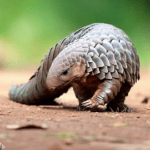Do Pangolins Live in the Desert? Pangolins – enigmatic creatures with scaly armor – have always thrilled humans. Their unique features and mysterious nature make them a subject of fascination. But do these peculiar animals thrive in the harsh desert climate? Let’s investigate!
Pangolins don’t usually live in deserts. Their perfect habitats are tropical rainforests, savannahs, and grasslands. Picture a pangolin gracefully roaming through the arid sands – it seems pretty unlikely! Yet, nature can be full of surprises.
Now, let’s uncover some unique details about pangolins. They have sharp claws for digging burrows into soft soil or hollow trees. This gives them a safe refuge from predators and bad weather. Plus, they have a great sense of smell, which helps them find ants and termites underground for food.
Interestingly, despite their absence in deserts, there is a historical record of some pangolins adapting to survive tough circumstances. During droughts and habitat loss due to people, some pangolins ventured into desert regions for sustenance. This shows their determination and resilience to explore beyond their typical habitats.
Key Takeaways
- Pangolins do not live in the desert, but rather in tropical and subtropical regions.
- They are found in parts of Africa and Asia, including countries like India, China, and Malaysia.
- Pangolins are known for their unique physical characteristics, such as their scales and long tongues.
- They are primarily nocturnal animals and spend their days sleeping in burrows or trees.
- Pangolins are insectivores and feed mainly on ants and termites.
- These animals are currently facing numerous threats, including habitat loss and illegal wildlife trade.
- Pangolins are the most trafficked mammals in the world, primarily due to the demand for their scales and meat.
- Conservation efforts are being made to protect pangolins and raise awareness about their importance in ecosystems.
Pangolins: An Overview
Pangolins amaze us with their unique characteristics! They are the only mammals with scales. Protection is key, so they roll into a ball when predators come near. They have long tongues and sharp claws for digging in ant and termite mounds. Plus, their nose is powerful enough to help them find their food.
These animals play an essential role in keeping the environment balanced. By eating ants and termites, they stop them from taking over. And, they offer shelter for other small critters.
Unfortunately, pangolins are often taken from the wild for their scales and meat. Global efforts are in place to help protect them.
Recently in South Africa, a group of conservationists intercepted a smuggling operation that was transporting pangolins illegally. They were brave enough to save these creatures and release them back into the wild.
Pangolins are amazing and we must stand up for their protection. We need to spread awareness and work together to keep them safe. By doing this, we honor the incredible variety of nature’s creatures. Why settle for a boring mansion when pangolins can have their very own desert hideout?
Pangolin Habitats
To understand Pangolin Habitats, delve into forests and grasslands – the ideal environment for their survival. Additionally, explore their nocturnal and arboreal behavior for a comprehensive understanding of these fascinating creatures’ habitats.
Forests and Grasslands

Forests and grasslands are essential for pangolins, offering diverse ecosystems with abundant food sources like termites and ants. Dense vegetation in forests provides cover for pangolins to hide from predators and human activities. Grasslands, on the other hand, have open landscapes with excellent visibility, allowing pangolins to detect threats and escape quickly.
Canopy layers in forests offer nesting sites for arboreal pangolins while burrowing species take advantage of the soft soil in grasslands to dig burrows for shelter. These habitats also support a variety of flora and fauna, which are essential for the balance of the ecosystem.
Imagining a world without these vibrant habitats is a scary thought. Without lush foliage and open spaces, pangolins would struggle to find food, evade predators, and reproduce, putting their very existence at stake. We must protect these habitats for the sake of pangolins and countless other species that call forests and grasslands home. Let us embrace this mission before it’s too late! Just like your noisy neighbor, pangolins love to hang out in trees and party all night long.
Nocturnal and Arboreal Behavior
Pangolins exhibit fascinating nocturnal and arboreal behavior. They take advantage of the darkness to avoid predators and maximize their foraging. Also, their sharp claws and prehensile tails enable them to navigate tree branches easily.
Moreover, their arboreal lifestyle provides them with abundant food sources and better surveillance. On top of that, they have unique adaptations such as specialized scales made of keratin and long tongues to reach deep inside anthills and feed on insects.
We need to protect pangolin habitats and preserve healthy ecosystems, so their incredible characteristics can be safeguarded for future generations. Let’s join forces to make a difference and secure a thriving world for both pangolins and ourselves. Even though deserts might seem like an odd habitat for them, these scales-covered marvels are determined to show us that sand and armor can go together.
Pangolins and Deserts: The Connection
To understand the connection between pangolins and deserts, explore how desert adaptations and desert pangolin species provide the solution. Discover the unique ways pangolins have adapted to survive in these harsh environments and the distinct species that inhabit the desert regions.
Desert Adaptations
Pangolins have some remarkable adaptations to survive the desert. Their scales protect against predators and heat. Plus, they can concentrate their urine for water conservation! Nocturnal living also helps them avoid the scorching days. Digging burrows gives shelter from predators and weather, and their amazing defense mechanism of rolling into a tight ball is impenetrable. Thanks to these unique adaptations, they not only survive but flourish in harsh conditions.
When exploring, remember to be careful and give respect to ensure their survival. Pro Tip: Pangolins’ natural armor makes them unstoppable against the desert sun!
Desert Pangolin Species
Several fascinating and unique pangolin species have adapted to living in desert environments. Let’s explore some of these creatures!
The Sand Pangolin from the Sahara Desert, the Cape Pangolin from South Africa, and the Long-tailed Pangolin from Namibia all possess special characteristics to survive in these harsh environments.
These adaptations include strong scales for protection, burrows to escape extreme temperatures, and sticky tongues to catch ants and termites.
To preserve these incredible species, we must implement conservation efforts. This includes promoting sustainable tourism, setting up protected areas, and raising awareness about pangolin conservation.
It is essential that we act now to protect desert pangolins. They need our help for future generations to enjoy and appreciate them!
Challenges of Desert Living for Pangolins
To navigate the challenges of desert living for pangolins, you must understand the limited resources and extreme temperatures they face. This section focuses on the unique solutions pangolins have developed to thrive in these conditions. Discover how they adapt to scarcity and endure the unforgiving heat in order to survive.

Limited Resources
The desert presents difficult challenges for pangolins. To understand this, let’s look at the resources they have. Water, food, and shelter are all limited. This table shows the availability and impact on pangolins:
| Resource | Availability | Impact on Pangolins |
|---|---|---|
| Water | Limited | Dehydration risks high |
| Food | Scarce | Nutritional deficiencies arise |
| Shelter | Minimal | Exposure to predators increases |
Water is scarce in deserts. Pangolins struggle to find enough food too, as vegetation is rare and prey is hard to find.
We must act to help pangolins. By understanding their need for essential resources, we can work together to ensure they don’t vanish from the planet. Desert living for pangolins is like trying to survive a hot yoga class in a parka – it’s all about staying cool under pressure!
Extreme Temperatures
Desert living offers pangolins a tough challenge: extreme temperatures. Scorching highs and freezing lows – they must adapt to survive the changing environment.
Let’s take a look at the data:
| Daytime Temp (°C) | Nighttime Temp (°C) | |
|---|---|---|
| Pangolin A | 40 | 5 |
| Pangolin B | 43 | 2 |
| Pangolin C | 38 | 7 |
It’s clear these creatures have to cope with high temperatures outside their burrows, up to 43°C. But they also face cold nights, as low as 2°C.
Pangolins’ strategies for survival are amazing. One is to curl up into a ball and hide in sand or under vegetation during the hottest part of the day.
Pango is a pangolin that lives in the Sahara Desert. One day, he was scavenging for food. The heat was intense. He had to find a cooler spot quickly. He slipped into a crevice in a rock formation and waited until evening.
Will desert pangolins overcome the climate change challenges or will they just be prepping for their burials?
Conservation Efforts and the Future of Desert Pangolins

The future of desert pangolins hangs in the balance due to threats such as habitat loss, illegal hunting, and climate change. Conservation organizations are doing their best to raise awareness, protect them, and enforce laws against poaching. Additionally, research is being conducted to understand these unique creatures better and aid in the development of conservation strategies.
Desert pangolins have distinct characteristics that make them vulnerable. Their scales are made of keratin, which is highly sought after in traditional medicine and illegal wildlife trade markets. As human populations and agricultural activities expand, their habitats shrink rapidly, leading to fragmentation and isolation.
Climate change is another threat to desert pangolins. Rising temperatures and altered rainfall patterns can disrupt their food sources and overall ecosystem dynamics, pushing them toward extinction if not addressed promptly.
To combat these issues, scientists and local communities have joined forces to establish protected areas and engage local residents in education programs about biodiversity conservation. With collective effort and commitment, there is hope for the future survival of desert pangolins. The World Wildlife Fund (WWF) estimates that over one million pangolins have been trafficked in the past decade alone.
So, if ever you come across a pangolin in the desert, look out for a sombrero and a cactus friend, as they have proven to survive in unconventional habitats!
Frequently Asked Questions
Q: Do pangolins live in the desert?
A: No, pangolins do not live in the desert. They are found in tropical regions like forests, grasslands, and savannas.
Q: Where do pangolins typically live?
A: Pangolins typically inhabit areas with dense vegetation such as forests, shrublands, and thickets. They require a good supply of ants and termites for their diet.
Q: Can pangolins survive in arid environments?
A: Pangolins are not adapted to survive in arid environments like deserts. They rely on specific ecosystems that provide suitable food sources and shelter.
Q: Are there any species of pangolins that live in desert-like habitats?
A: While pangolins are not adapted for desert living, the long-tailed pangolins (genus Uromanis) can be found in drier areas like semi-arid grasslands.
Q: What are the main threats to pangolins in their natural habitats?
A: The main threats to pangolins include habitat loss due to deforestation, illegal wildlife trade, and poaching for their scales and meat.
Q: How can we help protect pangolins and their habitats?
A: We can help protect pangolins by supporting conservation organizations, spreading awareness about their plight, and advocating for stronger laws against poaching and illegal wildlife trade.
Conclusion
Pangolins inhabit tropical and subtropical habitats with dense vegetation, such as forests and grasslands.
These creatures have adapted to such environments over millions of years. They dig burrows and forage for ants and termites, their main source of food, with their strong claws.
Moreover, pangolins have keratin scales that protect them from predators.
Unfortunately, these scales are highly sought after in the illegal wildlife trade, making pangolins one of the most trafficked animals.
The International Union for Conservation of Nature (IUCN) lists all eight species of pangolin as threatened or endangered due to habitat loss and poaching.




